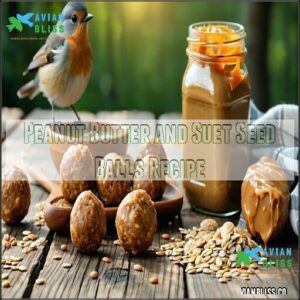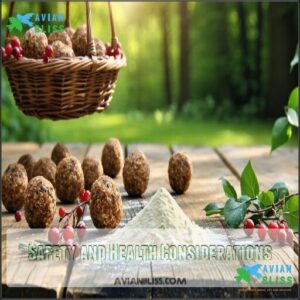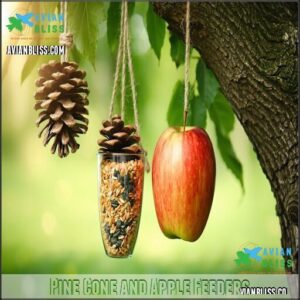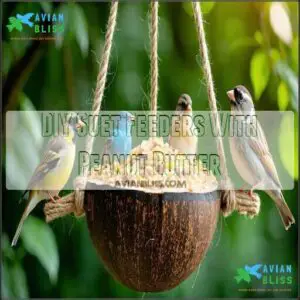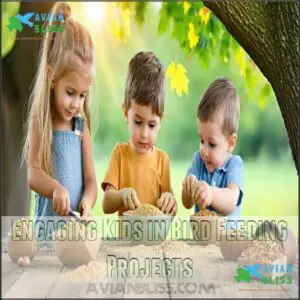This site is supported by our readers. We may earn a commission, at no cost to you, if you purchase through links.
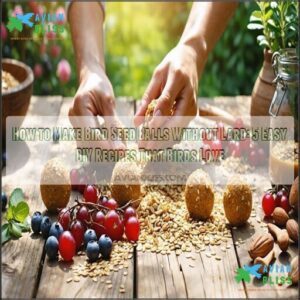 You can make bird seed balls without lard using simple, healthy substitutes.
You can make bird seed balls without lard using simple, healthy substitutes.
Peanut butter works great as a sticky binder, holding seeds together like glue. Coconut oil is another solid option—it melts when warm, letting you mix in seeds, then hardens to lock everything in place.
You could even mix in flour and water for an all-natural paste. Combine your ingredients into a sticky dough, shape it into balls (think snowball size), and let them chill in the fridge.
Birds will flock to the buffet you’ve created, and you’ll love seeing those happy little visitors. Ready for more creative feeder ideas?
Table Of Contents
- Key Takeaways
- Benefits of Bird Seed Balls
- Making Bird Seed Balls Without Lard
- Bird Seed Ball Recipes
- Safety and Health Considerations
- Creative Bird Feeder Ideas
- Frequently Asked Questions (FAQs)
- What can I use to bind bird seed together?
- What can I use instead of lard to make bird feeders?
- How do you stick bird seeds together without gelatin?
- How to prevent seed balls from crumbling?
- Can bird seed balls attract unwanted pests?
- What are the best seeds for specific birds?
- How to make seed balls last longer outdoors?
- Are homemade seed balls effective in wet climates?
- Conclusion
Key Takeaways
- You can use alternatives like peanut butter, coconut oil, or vegetable suet to bind bird seed without lard; they’re nutritious and easy to handle.
- Avoid salt, moldy seeds, or fillers like cracked corn, as they can harm birds or provide little nutrition.
- Keep feeders clean and inspect seed balls regularly to prevent mold or pest issues.
- Store seed balls in shaded, dry areas or the freezer to make them last longer and maintain their shape outdoors.
Benefits of Bird Seed Balls
You’ll provide wild birds with essential fats and carbohydrates they need to survive cold winters when you offer homemade seed balls in your garden.
Homemade seed balls give wild birds the energy they need to thrive during harsh winter months.
These compact food sources help birds replenish the 75% of fat stores they lose overnight, giving them energy for flight while attracting a variety of colorful species to your yard, which is crucial for their survival during harsh winters.
Importance of Bird Feeding in Winter
Compassion during the coldest months can make a life-or-death difference for our feathered neighbors.
Winter bird feeding provides vital support when natural food sources are scarce and energy demands are highest.
Five key reasons winter bird feeding matters:
- Supports pest control as birds hunt insects year-round
- Enhances winter survival rates in your local bird population
- Enables critical fat replenishment after overnight depletion
- Provides reliable energy sources during harsh weather conditions
- Assists birds during migration stopovers or range extensions
Nutritional Needs of Wild Birds
While winter sends birds searching for food sources, understanding their nutritional needs is key to helping them thrive.
Wild birds require a balanced diet of fats and carbohydrates for survival.
Fat serves as their primary energy source, with birds losing about 75% of their fat stores overnight, which is why they need daily replenishment of these stores.
They need high-quality birdseed with proper fat sources, which becomes their winter lifeline.
Energy and Insulation for Birds
Birds rely heavily on fat as their primary Winter Fat Stores, consuming it for both Energy Replenishment and warmth.
Fat is a bird’s winter superpower, fueling flight, warmth, and survival through the coldest nights.
When you provide bird seed balls with proper nutrition, you’re helping feathered visitors survive harsh conditions. Offering high-calorie seeds guarantees birds have the necessary long-lasting energy for survival.
- Birds lose about 75% of their fat reserves overnight in winter
- Carbohydrate Sources fuel daily activities and body heat production
- Feather Insulation works better when birds have adequate nutrition
- Fats serve as Migration Fuel for seasonal travelers
- High-energy homemade bird food supports critical metabolic needs
Making Bird Seed Balls Without Lard
You can make nutritious bird seed balls without lard by using plant-based alternatives like peanut butter, vegetable suet, or coconut oil that provide the same essential fats birds need for energy and warmth.
These lard-free options actually stick together better in warmer weather, so your feathered visitors won’t find themselves in a melty mess when spring arrives, which is a significant advantage of using plant-based alternatives.
Alternative Ingredients to Lard
I’ll create a 60-word article section on "Alternative Ingredients to Lard" for bird seed balls.
While traditional bird seed balls rely on lard, you’ve got plenty of bird-friendly alternatives.
Unsalted butter works in a 1:1 ratio, though it’s not ideal for warm weather.
Vegetable shortening mimics lard’s consistency perfectly, and coconut oil offers a healthier option that solidifies when chilled.
For completely suet-free bird balls, try the clay-compost method—combining powdered clay with compost creates an excellent natural base, using unsalted butter or vegetable shortening as alternatives.
Using Peanut Butter and Suet
Backyard bird enthusiasts swear by peanut butter and suet as perfect lard alternatives in bird seed balls.
These ingredients provide ideal fat content birds need during cold months.
Peanut butter benefits include protein and easy spreading, while suet nutritional value comes from its high energy density.
You can find various types available for different bird preferences.
Mix them in safe ratios of 1:1 for best results. Most bird species show strong preferences for these tasty combinations.
Mixing Ingredients and Shaping Balls
Mixing your bird seed balls is all about getting the right consistency.
Once you’ve chosen your binder (peanut butter or suet), follow these simple steps:
- Warm your binder slightly to make it easier to work with
- Add seeds gradually while stirring to prevent clumping
- Form balls by hand or use mould alternatives like yogurt cups
The mixture should be sticky enough to hold together but firm enough to maintain shape when dried, which is crucial for the bird seed balls to be effective.
Bird Seed Ball Recipes
You’ll find these lard-free bird seed ball recipes use ingredients you probably already have in your pantry, like peanut butter, coconut oil, and vegetable suet.
Each recipe creates a nutritious, energy-rich treat that helps wild birds maintain their essential fat stores during cold weather when they need it most.
Suet-Based Seed Balls Recipe
In just under an hour, you can prepare suet-based seed balls that birds will flock to your garden for.
Mix 1 cup rendered suet with 2 cups dry ingredients (birdseed, quick oats, cornmeal, and flour) at a 1:2 ratio.
Melt the suet, combine thoroughly with your seeds, then press into molds. You can easily find rendered suet options online.
Freeze for 1-2 hours before hanging. They’ll store in your freezer for up to 3 months!
Peanut Butter and Suet Seed Balls Recipe
Combining the hearty richness of peanut butter with traditional suet creates a bird seed ball that’ll have your feathered friends flocking to your yard.
Mix 1 cup of peanut butter (use single-ingredient varieties) with 1 cup of suet, then fold in 2 cups of quality birdseed.
For recipe variations, adjust ingredient ratios based on bird preferences in your area—chickadees typically love extra peanut butter while woodpeckers prefer suet-heavy mixtures.
Coconut Oil Seed Balls Recipe
While peanut butter works wonders, coconut oil offers another fantastic base for your bird seed balls.
It’s solid at room temperature but melts easily for mixing. Here’s your simple no-lard recipe:
- Warm 1 cup of coconut oil until just melted
- Stir in 2 cups of mixed bird seed (try black oil sunflower seeds for extra nutrition)
- Pour into silicone muffin moulds and refrigerate until firm
Store unused treats in the freezer for up to three months.
Sunflower seeds are great because they provide fat and protein.
Safety and Health Considerations
You’ll need to take into account more than just ingredients when making your bird seed balls, as proper preparation and placement can make the difference between helping your feathered friends and accidentally causing harm.
While you’re crafting these nutritious treats with alternatives to lard, remember that clean feeders and awareness of toxic foods are just as important as the recipe itself.
Foods to Avoid in Bird Seed Balls
Now that you’ve mastered the recipes, let’s talk about what NOT to put in your bird seed balls.
While you’re trying to help your feathered friends, certain ingredients can actually harm them.
Avoid cheap fillers like wheat and cracked corn, which offer little nutrition.
Never use moldy seeds—they can produce toxic aflatoxin.
Skip onions, garlic, and fruit seeds containing cyanide compounds.
Salt is a big no-no for birds, as are unsuitable fats that can cause feather contamination.
Birds also have sensory limitations, so spoiled food is dangerous.
Importance of Clean Feeders and Storage
While avoiding toxic ingredients is essential for bird health, equally important is how you maintain your feeders.
Clean feeders prevent the spread of diseases that can devastate bird populations.
Keep your bird feeding stations healthy with these practices:
- Clean feeders weekly with a 10% bleach solution
- Store unused bird seed balls in airtight containers in the freezer
- Inspect feeders regularly for mold or pest infestations
- Remove wet or moldy seed immediately
- Position feeders where droppings won’t contaminate food and water to maintain bird health and prevent the spread of diseases.
Seasonal Considerations for Bird Feeding
Keep seasonal needs in mind when feeding.
Winter feeding helps birds survive cold nights, while summer feeding supports breeding season and growing young.
Migration support in fall and spring is essential as birds prepare to journey.
A no lard recipe for DIY bird treats works year-round, and birdseed recipes without lard guarantee proper nutrition, meeting birds’ needs effortlessly, which is crucial for their proper nutrition.
Creative Bird Feeder Ideas
You can get creative with bird feeders by using everyday items like pine cones, apples, or cupcake trays as bases.
These simple ideas turn household supplies into functional feeders, keeping your backyard birds happy and well-fed.
Pine Cone and Apple Feeders
A pine cone or apple makes a great base for DIY bird treats.
Coat it with alternative adhesives like peanut butter, then roll it in a seed mix.
Apple feeder benefits include being biodegradable and easy to hang with string.
Pine cone variations work well too, and Selecting materials like cedar can enhance durability.
Place feeders where birds feel safe—shaded, high spots work best!
DIY Suet Feeders With Peanut Butter
If apples and pine cones aren’t your thing, peanut butter offers a sticky shortcut for birdseed recipes without lard.
Use smooth, unsalted peanut butter as a suet alternative option. Spread it on a sturdy base, sprinkle seeds, and hang. It’s a quick DIY birdseed fix!
Plus, you can find supplies for feeders online.
Plus, this feeder placement strategy works wonders in shaded spots, avoiding messy meltdowns, and is a great way to use smooth peanut butter.
Engaging Kids in Bird Feeding Projects
Kids love hands-on activities, and making birdseed balls is a great way to inspire outdoor learning and nature appreciation.
Try a no-lard recipe using peanut butter or suet for an easy birdseed project.
This fosters creative expression, responsibility skills, and family bonding.
Let them shape the mix into fun molds while learning the importance of helping wildlife through simple DIY birdseed recipes without lard, which promotes nature appreciation.
Frequently Asked Questions (FAQs)
What can I use to bind bird seed together?
Did you know birds lose 75% of their fat overnight?
To help them refuel, use peanut butter, coconut oil, or suet as a binder for birdseed.
They’re sticky, nutritious, and birds absolutely love them!
What can I use instead of lard to make bird feeders?
You can use peanut butter, coconut oil, or vegetable suet instead of lard for bird feeders.
These options provide essential fats and energy for birds, especially during winter, and are easy to work with.
How do you stick bird seeds together without gelatin?
You can mix peanut butter, suet, or coconut oil with birdseed to hold it together.
Melt the fat alternative slightly, stir in seeds, and shape into balls.
Let them cool to solidify.
How to prevent seed balls from crumbling?
Keep seed balls from crumbling by using a binding agent like peanut butter or coconut oil.
Make certain the mix isn’t too dry—add a little water if needed.
Pack tightly, and let them solidify completely, this will help prevent them from crumbling.
Can bird seed balls attract unwanted pests?
Imagine rolling a red carpet for pests instead of birds—seed balls can attract unwanted guests like rodents if placed improperly.
Hang them high, away from cluttered areas, and clean up spilled seeds regularly to avoid trouble.
What are the best seeds for specific birds?
Cardinals love sunflower seeds, while finches prefer nyjer seeds.
To attract doves, scatter millet or cracked corn on the ground. Chickadees enjoy peanuts or safflower seeds.
Choose seeds based on the species visiting your yard to attract the right birds!
How to make seed balls last longer outdoors?
Ever wonder why seed balls don’t last long?
Add a pinch of powdered clay to bind the seeds and protect them from moisture.
Store them in shaded areas to avoid melting and keep birds happy.
Are homemade seed balls effective in wet climates?
Homemade seed balls can work in wet climates, but you’ll need to use binding agents like suet, clay, or peanut butter to keep them intact.
Hang them in sheltered spots to reduce rain exposure.
Conclusion
Whether you use peanut butter, coconut oil, or a flour-and-water paste, making bird seed balls without lard is simple, fun, and rewarding.
These DIY creations provide essential nutrients, helping birds stay energized, especially in colder months.
By experimenting with recipes, you’ll attract a variety of feathered friends to your yard.
Just remember to avoid harmful ingredients like salt or processed foods and keep feeders clean, which is a crucial step in ensuring the health and well-being of the birds, and watching happy birds enjoy your feeders is a joyful way to connect with nature.
- https://www.allaboutbirds.org/Page.aspx?pid=1180
- https://www.perkypet.com/articles/birds-hate-these-foods?srsltid=AfmBOoqhqhSr_bfm71qAWc2tiZlEPhUPEooRhW4gn2-oQs4smo76g1cr
- https://www.gardensforwildlife.ie/post/5-things-to-avoid-when-bird-feeding
- https://avianreport.com/foods-unsafe-for-wild-birds/
- https://awesomewildlifeco.co.uk/blogs/help-advice/what-not-to-feed-wild-birds-top-tips?srsltid=AfmBOorPif3tJgdv5oqzDgXpNNnot_Kzbo2ppIWEpBzA9HvKcHoFA2eO




